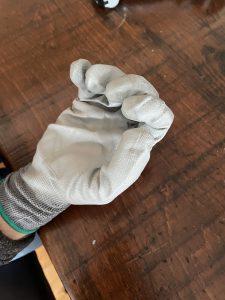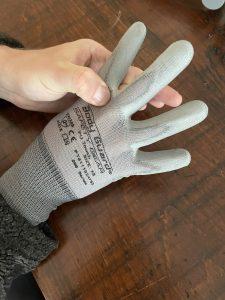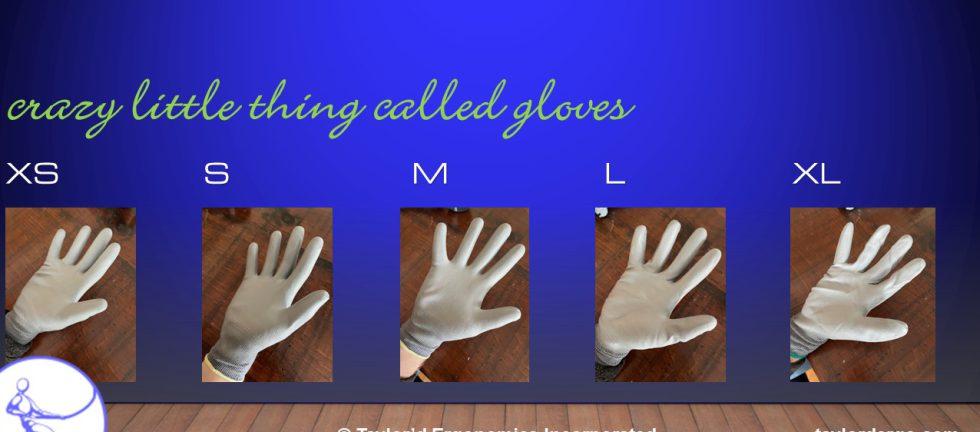The skin on our bare hands provides an ideal grip for handling most objects in day-to-day life. Our palms and fingers are relatively tough, grippy, and sensitive to heat and pressure. For many tasks, bare-handed is the way to go. Most people can’t imagine wearing gloves to type, use a pen, brush our teeth or drive a car. However, in the workplace and at home, certain tasks require us to wear gloves, to protect our hands from hazards:
- Insulating gloves protect us from heat or cold
- Nitrile or latex gloves protect us from chemicals
- Cut-resistant gloves protect us from sharp tools or parts
- Tacky gloves help us grip heavy or slippery items
- Waterproof gloves keep our hands dry
As with other hazards, if you can eliminate the hazard, you won’t need personal protective equipment (PPE). But when you need PPE, choose wisely.
When choosing gloves, consider:
- The type of hazard your hands are exposed to – heat, cold, chemicals, vibration, etc. Obviously, a glove’s main job is to keep your hand safe.
- How much dexterity is required. Thinner gloves allow you to “feel”. Fingerless gloves protect the palm but keep the fingertips available. Tacky (coated) gloves help you grip slippery items.
- Tools used – Slippery or bulky gloves may make tasks requiring dexterity or precision more difficult.
- If the gloves have seams, the seams should not be located between your hand and the tools or items you handle. Seams in these locations will create pressure that could lead to blisters or callouses.
When it comes to gloves, fit matters! If gloves do not fit properly, they can present a hazard.
Poorly-fitting gloves can:
- Increase how much effort you use to grip something. Extra fabric decreases dexterity – you cannot “feel” through the glove and so you may grip tighter. If the gloves are slippery (cotton or nitrile) and the object that you are handling is slippery or very smooth, you’ll have to grip harder to maintain control of the item.
- Cut off circulation, if they are too tight.
- Create a safety hazard by getting caught in moving equipment.
When it comes to gloves…one size does NOT fit all!
- If possible, try on gloves before purchasing. If you’re ordering online, use the manufacturer’s sizing guide.
 2. Your palm and fingers should fill the glove, with no extra material in the palm or fingertips. Finger “flaps” are a sign that the glove is too large. Wrinkles of fabric in the palm and fingers are another giveaway, as shown at right.
2. Your palm and fingers should fill the glove, with no extra material in the palm or fingertips. Finger “flaps” are a sign that the glove is too large. Wrinkles of fabric in the palm and fingers are another giveaway, as shown at right.
3.  The fingers should be long enough to avoid “webs” between your fingers.
The fingers should be long enough to avoid “webs” between your fingers.
4. The gloves should not be tight around your wrist.
5. If you can’t find the right size glove at your workplace, tell your supervisor! Employers, please make sure you supply gloves in the full range of sizes required by your employees! Glove manufacturers need to be reminded that extra small workers need extra small gloves; many gloves are still only produced in large sizes.
The photos in the header above show one hand trying on 5 different glove sizes. We had “Saturday-morning-fun-with-gloves”. I asked my “volunteer” to try on each glove and then squeeze a grip dynamometer as hard as he could, so I could measure his strength. I gave him rest between trials, and I presented the gloves in a random order. (If I wanted this to be a more scientific study, he would have needed more rest, and I would have run the trials several times on different days….this was just for “fun”.)
With no glove, he produced 120 lbs of grip force. With gloves, his strength maxed at 112 lbs in a size S (small) and was lowest with the XS (105 lbs) and the XL (109 lbs). (For myself, I gave 55 lbs with an XS, 60 lbs with my bare hand, and only 50 lbs with an L glove.)
Why does optimizing grip strength matter? Performance is best when the job requires less effort, relative to the worker’s strength. “Performance” includes comfort, safety, productivity, and quality outputs.
The crazy little thing? When it comes to gloves, fit matters!
Thanks to Leslie Beechey and Fastenal in Cambridge for providing the set of “Body Guard ® Safety Gear PU Touch” gloves.


